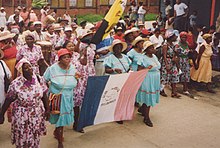Garifuna
Garifuna , in the Garifuna language in the plural Garinagu , are an ethnic group with over 100,000 members in Central America and the USA . It emerged from a mixture of black slaves of West African origin with indigenous Caribs , which took place on the Caribbean island of St. Vincent from the 17th century . The name originally means “ yam eater ” in the Garifuna language .
Origin and history
The union of the two population groups probably began in 1635 when two slave ships were shipwrecked near St. Vincent . The Africans were able to flee, were taken in by the island caribs ( Kalipona ) and mixed with them. The Caribs had previously merged with the Arawak they had once subjugated .
The further history of the ancestors of the Garifuna on St. Vincent was shaped by the Franco-English competition in the Caribbean and especially by the slave economy: The Garifuna, who repeatedly managed to maintain their independence, not least because of the Franco-English competition, and who lived largely peacefully with the French settlers, were viewed with suspicion by the colonial masters and new colonists after the final British occupation of the island in 1795 and the accompanying expansion of the slave economy (on sugar cane plantations), as they set an example of free blacks in mind. Armed conflicts between the British on the one hand and Garifuna and the French on the other ( Caribbean War ) ended in 1796 with the complete defeat of Garifuna and the French. The defeated Garifuna were first deported - together with some rebellious slaves - to the nearby island of Baliceaux , where more than 50% of the prisoners died. Therefore, on February 20, 1797 2248 "Black Caribs" (were Black Caribs ) by the British from Baliceaux to the island of Roatan resettled before the Honduran coast. From here the Garifuna spread across the Bay Islands . Around 1832, many Garifuna emigrated to Belize .
Culture
Their language, the Igñeri , belongs to the indigenous American Arawak language family and shows indigenous Caribbean , French and English and, more recently, regionally Spanish influences as well. The isolated African influences in the Igñeri are most likely to come from the Yoruba in southwestern Nigeria. The religious and cultural tradition is predominantly (West) African.
In addition to the language, certain dance forms such as the circle dance and to some extent the punta dance, certain legends and individual ritual practices that are still found today in a similar form among certain Amazon tribes are of Caribbean origin . Other religious customs and traditions, as well as Parranda music, show a close relationship with old West African cults and practices (the Yoruba , the Mandé or the Ashanti ). This includes ancestor worship , which is expressed in a three to four day ritual called Dügü , in which the ancestral spirits are conjured up. The ethnological debates on the origin of individual traditions are still in flux and are partly subject to the fluctuating interest in postulating a rather old African (i.e. imported) or a rather old Indian (i.e. autochthonous) origin.
The language, dance and music of the Garifuna was recognized by UNESCO as a Masterpiece of the Oral and Intangible Heritage of Humanity in 2001 and was added to the Representative List of the Intangible Cultural Heritage of Humanity in 2008.
Todays situation
The more than 100,000 Garifuna now live in Belize , where they make up up to 7% of the population, in Guatemala , Honduras and Nicaragua mostly as fishermen on the coast and as workers in banana cultivation. Many Garifuna also live as immigrants in the USA, mainly in the city of New York .
In recent years the Garifuna culture has also been discovered more and more by the tourism industry. Today's Garifuna speak Igñeri and, depending on the country, English or Spanish.
According to Garifuna.com, the following organizations in particular strive to represent (also) the interests of the Garifuna :
- ODECO ( Organización de Desarrollo Étnico Comunitario )
- OFRANEH ( Organización Fraternal Negra Hondureña )
- ONECA ( Organización Negra Centroamericana / Central American Black Organization )
See also
literature
- Ève Demazière: Les cultures noires d'Amérique Centrale. Karthala, 1994.
- Barbara AT Flores: Religious education and theological praxis in a context of colonization: Garifuna spirituality as a means of resistance (Ph.D. Dissertation, Garrett / Northwestern University, Evanston, Illinois), 2001.
- NL Gonzalez: The Garifuna of Central America. In: Samuel M. Wilson (Ed.): The Indigenous People of the Caribbean. Pp. 197-205, 1997.
- Salvador Suazo: Conversemos en garífuna . Tegucigalpa 1994.
Web links
- Literature about the Garifuna in the catalog of the Ibero-American Institute in Berlin
- http://www.garifuna.com
- http://www.mayaparaiso.com/garifuna.php
- http://www7.nationalgeographic.com/ngm/data/2001/09/01/html/ft_20010901.6.html
- http://www.clas.ufl.edu/users/afburns/afrotrop/Garifuna.htm
- http://www.nativeplanet.org/indigenous/garifuna.htm
- Katharina Wilhelm: The feet go slowly, the drums go fast . faz.net, October 10, 2016
Individual evidence
- ↑ Oliver N. Greene: The "Dügü" Ritual of the Garinagu of Belize: Reinforcing Values of Society Through Music and Spirit Possession. In: Black Music Research Journal, Vol. 18, No. 1/2 spring – autumn 1998, pp. 167–181
- ↑ http://www.unesco.org/culture/ich/index.php?lg=en&pg=00011&RL=00001
